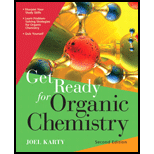
Concept explainers
Interpretation:
The mechanisms for the competing
Concept introduction:
The
The nucleophile forms a bond with the electrophilic carbon in the substrate, with the bond between that carbon and the leaving group breaking at the same time. Since the leaving group hasn’t departed when the nucleophile-carbon bond is formed, the nucleophile must approach the substrate from a direction opposite to the leaving group. This results in an inversion of configuration if the reaction center is a chiral carbon.
The
The E2 is a single-step, bimolecular elimination reaction. A proton from a carbon adjacent to the one attached to the leaving group is extracted by a base. The
An E1 reaction is a two-step, unimolecular reaction. The first step of E1 is the same as the first step of the
Want to see the full answer?
Check out a sample textbook solution
Chapter 9 Solutions
Get Ready for Organic Chemistry
- 5) 2-methyl-1,3-cyclohexadiene is treated with 1 equivalent of HCl. There are two major products. One product predominates at high temperature, and the other at low temperature. HCI a) Write the mechanism for this reaction. b) Label one product as the high temperature product and one as the low temperature product.arrow_forwardDraw the mechanism for this reaction.arrow_forwardWhen cyclohexene is reacted with hydrobromic acid in acetic acid, the major product is bromocyclohexane. There is a small amount of cyclohexyl acetate formed. What is the mechanism that forms both compounds? What is the purification procedure that isolates both compounds?arrow_forward
- The following compounds undergo an E2 step when added together. Draw the mechanism for this elementary step and the resulting products. Br H3C H3C H -CH3 H HOarrow_forwardThe deuterated ethanol shown can be converted to an alkyl halide via a mesylate intermediate. Complete the mechanism, draw the final product (with nonbonding electrons) and select the correct absolute stereochemistry of the starting material and the final product.arrow_forwardWhen acetone is dissolved in either a slightly basic or a slightly acidic solution of oxygen-18 labeled water, H2180, oxygen-18 labeled acetone, (CH3)2C=180, is produced. This is a form of an isotopic exchange reaction between acetone and water. Provide a mechanism to account for this reaction in (a) basic solution and (b) acidic solution. Hint: Is the addition of the nucleophile reversible or irreversible? 180 + H,180 CH3 + Hо `CH3 Acid or base H3C H3Carrow_forward
- Draw the mechanism for the reaction (please include all arrows)arrow_forwardDrawing the SN1 and E1 Products in a ReactionDraw the SN1 and E1 products formed in the reaction of (CH3)3CBr with H2O.arrow_forwardDraw the following compounds and rank them according to their ElectrophilicAromatic Substitution reactivity. Show the reaction scheme of bromination for eachcompound. No mechanism is needed. Aniline, Benzaldehyde, Toluenearrow_forward
- Draw the products of each reaction. (a) and (b)arrow_forwardDraw the major and minor products for the following reaction. Identify the mechanism for each product (SN2, SN1, E2, E1). CI NaOMearrow_forwardDraw a veasonable mechanism for this reaction that involves free radicals. hv DH cat. OH Ph Pn H,Carrow_forward
